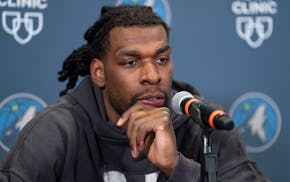The Twins in 2022 set a team record for most injuries despite extensively resting players and recently expanding their medical staff.
Injuries and ailments in professional sports are inevitable and pivotal. With reasonable health this season, the Twins probably would have made the playoffs. Instead, they finished six games below .500.
You could blame the Twins' medical staff, but they have hired people renowned in their field, including Dr. Christopher Camp, who became their medical director and Director of High Performance in 2020.
Chuck Barta became an athletic trainer for the Minnesota Vikings in 1988, and has been the Minnesota Lynx's head trainer since 2007. I've known and trusted him since we met in 1990.
His career predates MRIs. We both remember when athletes thought drinking beer the night before a game was an effective way to "carb load.''
"I remember when you'd go into a pregame meal and everyone was eating steak and eggs, and lots of fatty stuff,'' Barta said. "Now we realize that you need less fat, some protein, and more carbs. Now we are looking at micronutrients and doing bloodwork to see what an individual really needs. Yes, things have changed quite a bit.''
Barta has faced two different challenges — working with NFL players who played 16 games over four months, and WNBA stars who play year-round.
With the Vikings, Barta had anywhere from 13 to 28 players undergoing surgery in a given season. Level of care was not a variable.
He found that established players had a lower incidence of serious injury, because they didn't need to strain every day to keep their jobs, and they know how to manage their workload.
With the Lynx, he found that players, especially when overseas, determined their own health with their nutritional and rest habits.
Other points Barta made during a long conversation:
- Playing a sport year-round strengthens certain muscles, but weakens others. Year-round play can lead to repetitive stress injuries, and can also keep an athlete from investing time in strengthening the parts of the body required to support athletic movements.
- Many injuries went undiagnosed or underdiagnosed before modern technologies came into play. There was a time in the '80s and early '90s when the "groin strain'' became a popular description for an injury. Upon the introduction of tests like MRIs and ultrasounds, trainers were able to discern whether the injury was actually a groin strain, or related to the abdomen.
- In cases like the Twins' 2022 season, injuries can beget injuries. "If a front-line player goes down, they may be replaced by someone not accustomed to playing every day, or who exerts themself so much to prove themselves that they get injured, too,'' Barta said. "You can have a cascading effect.''
- A player who is injured frequently in college is a good bet to deal with the same problems in the pros, unless they change their habits.
- Different tests reveal different results. An MRI might show a calf strain, while an ultrasound might reveal damaged tissue in greater detail.
- Luck can be a major factor.
- Mental breaks can be as important as physical breaks.
- Modern technology, including wearable tech, can help determine how hard a player can be pushed in workouts or practices.
Barta pointed to Sylvia Fowles as an example of a player who extended her career through self-care. "She paid attention to the littlest details,'' Barta said.
I covered Kirby Puckett, who never worked out in the winter and never went on the disabled list until he contracted glaucoma, and I've covered athletes who invested heavily in offseason workout programs and afterward became injury prone.
The challenge, as one general manager told me recently, is that modern athletes know they have to be explosive to compete, but building explosiveness strains the body.
That may be why Byron Buxton — the Twins' fastest runner and most powerful hitter, and someone who works out extensively in the offseason — has suffered a variety of injuries.
"Technology in our field has come a long way,'' Barta said. "What has stayed the same is that a lot of this comes down to how athletes manage themselves away from the team.''

Vikings, GM Kwesi Adofo-Mensah agree to contract extension

Basketball: Purdue, Iowa State among colleges pursuing Totino-Grace rising junior Malachi Hill
Carlos Correa sees offensive surge after slow start

Three key Timberwolves players could enter free agent market

